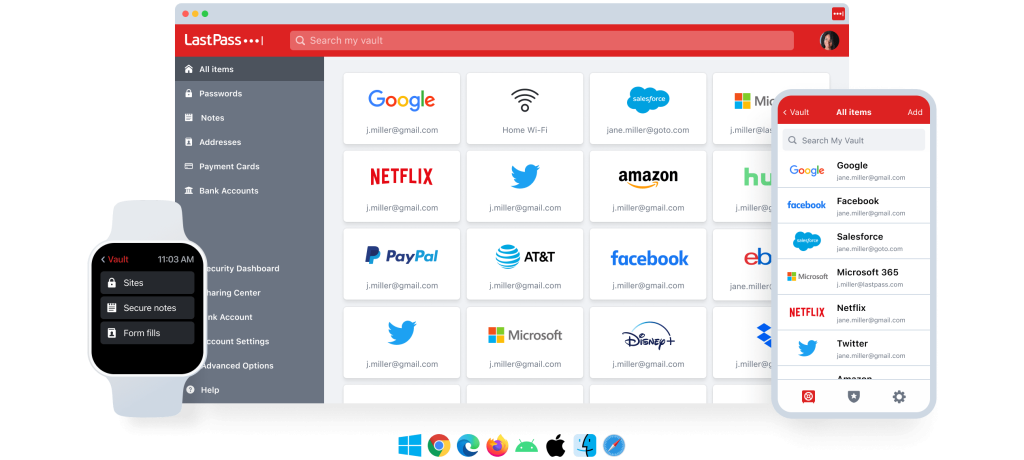One phrase stands out as a stark reminder of the constant threats users face in safeguarding their digital identities – password manager “free”. Password managers, once hailed as the ultimate solution to password-related woes, have recently come under scrutiny due to incidents like the LastPass breach. This article delves into the specifics of the LastPass breach, the broader context of password managers, and the crucial lessons we can glean from such incidents.

I. The LastPass Breach: Unraveling the Incident
In March 2022, LastPass, one of the most popular and widely used password managers, experienced a significant security breach that sent shockwaves through the cybersecurity community. The breach exposed sensitive user information, including email addresses, hashed master passwords, and some users’ salts.
- The Scope of the Breach:
The compromised information represented a potential goldmine for cybercriminals. Hashed master passwords, even if encrypted, could be vulnerable to brute-force attacks, where attackers systematically try different combinations until the correct one is found. The inclusion of user salts added a layer of complexity, but the breach highlighted that even robust security measures can be susceptible to breaches. - LastPass’s Response:
LastPass responded swiftly to the breach, taking immediate action to mitigate potential damage. Users were promptly notified of the incident and advised to update their master passwords. The company also enhanced its security measures and urged users to enable multi-factor authentication (MFA) for an added layer of protection. - Reassessing Security Protocols:
The LastPass breach prompted a reassessment of security protocols within the company. As a widely trusted password manager, LastPass faced the challenge of rebuilding user trust and ensuring that such incidents would be less likely to occur in the future. The incident underscored the dynamic nature of cybersecurity, emphasizing the need for constant vigilance and adaptation.
II. Password Managers: A Critical Tool in Cybersecurity
A. The Need for Password Managers:
The number of online accounts we create multiplies, making it practically impossible to remember unique, complex passwords for each one. Password managers emerged as a practical solution to this challenge, offering users a secure vault to store and generate complex passwords. These tools alleviate the burden of memorizing multiple passwords and enhance overall security by promoting the use of unique credentials for each account.
B. How Password Managers Work:
Password managers operate on the principle of creating and storing complex, unique passwords for each account a user possesses. These passwords are often a combination of letters, numbers, and symbols, making them considerably more robust than easily guessable alternatives. The master password, which grants access to the password manager vault, is the only code users need to remember. This enhances overall security while simplifying the user experience.

C. Features of Password Managers:
In addition to securely storing passwords, password managers offer a range of features to bolster digital security:
- Password Generation:
Password managers can generate strong, random passwords for users, eliminating the need for individuals to come up with their own complex combinations. - Secure Storage:
Passwords stored in a password manager are typically encrypted, adding an extra layer of protection against unauthorized access. - Autofill and Auto-login:
Password managers streamline the login process by automatically filling in credentials, reducing the risk of falling victim to phishing attacks that exploit manual entry errors. - Cross-Device Synchronization:
Users can access their passwords across multiple devices, ensuring a seamless and secure experience regardless of the platform.
III. The LastPass Breach: Lessons Learned
A. The Importance of Regular Audits:
The LastPass breach underscores the significance of routine security audits for password management platforms. Regular assessments of the system’s vulnerabilities can identify potential weaknesses before they are exploited by malicious actors. Users should be proactive in staying informed about the security practices of their chosen password manager and any updates or improvements implemented by the provider.
B. The Master Password as the Weakest Link:
While password managers offer robust security for stored credentials, the master password remains a crucial vulnerability. Users must prioritize creating a strong master password that is resistant to common hacking techniques. Additionally, enabling multi-factor authentication (MFA) adds an extra layer of security, requiring an additional verification step beyond the master password.
C. The Role of End-User Awareness:
The LastPass breach serves as a wake-up call for users to be more vigilant and proactive in managing their digital security. End-user awareness is paramount; individuals must understand the potential risks associated with using password managers and take necessary precautions, such as regularly updating passwords and implementing additional security measures.
IV. Password Manager Free vs. Premium: Striking the Right Balance
A. The Appeal of Password Manager Free Versions:
Many password managers offer free versions of their services, allowing users to experience the benefits without financial commitment. These free versions often include essential features such as password storage and generation, making them an attractive option for budget-conscious individuals. However, it’s crucial to recognize the limitations of free versions, particularly in terms of advanced security features and customer support.
B. Premium Features for Enhanced Security:
Password manager free versions typically come with limitations, such as a restricted number of devices, reduced customer support, and fewer advanced security features. Upgrading to a premium subscription often unlocks additional benefits, such as secure file storage, emergency access, and priority support. For users who prioritize comprehensive security and additional functionalities, investing in a premium password manager subscription is a wise decision.
C. The Balance between Cost and Security:
While password manager free versions offer a valuable entry point to enhanced digital security, it’s essential for users to assess their individual needs and consider whether the added features of a premium subscription justify the cost. Striking the right balance between cost and security ensures that users make informed decisions that align with their unique requirements.
V. The Future of Password Managers: Evolving Security Measures
A. Continuous Improvement in Encryption:
In response to security breaches like the LastPass incident, password managers are continually refining their encryption methods. Advanced encryption algorithms and techniques, such as zero-knowledge architecture, are becoming standard features, providing users with an added layer of confidence in the security of their stored credentials.
B. Integration with Emerging Technologies:
Password managers are increasingly integrating with emerging technologies to enhance overall security. Biometric authentication, such as fingerprint or facial recognition, is becoming a common feature, adding an extra layer of protection beyond traditional passwords. As technology evolves, password managers are likely to incorporate additional innovations to stay ahead of potential threats.
VI. Conclusion: Navigating the Digital Landscape with Caution
The LastPass breach serves as a poignant reminder that even the most robust cybersecurity measures are not foolproof. However, the incident should not dissuade users from utilizing password managers altogether. Instead, it emphasizes the need for a cautious and informed approach to digital security.
Password managers remain an invaluable tool in the fight against cyber threats, offering a practical and secure solution for managing the ever-growing number of online accounts. Users must stay proactive in their security practices, regularly auditing and updating passwords, and leveraging additional features like multi-factor authentication.
Whether opting for a password manager free version or investing in a premium subscription, users should carefully consider their individual needs and strike a balance between cost and security. As technology evolves, password managers will continue to play a pivotal role in safeguarding digital identities, provided users remain vigilant, informed, and proactive in their approach to cybersecurity.
Leave a Reply